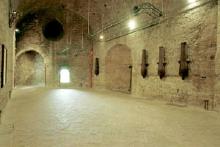|
|
| ||||||||
|
PERUGIA Art and monuments -
Rocca Paolina
As proof of the renewed dominion, in 1373 Albrornoz ordered a fortress to be built, the Rocca del Sole on the highest point of the town, the Colle del Sole (493 metres). Built according to plans by Gattapone da Gubbio, the fortress was the largest and best known of its time. Nonetheless if was completely destroyed by local citizens in a uprising just three years later. All that remains of it are the massive substructure walls that support what is now Piazza Rossi Scotti, formerly delle Prome, but usually called Porta Sole, from where there is a splendid view for 230° eastwards towards the Apennines.
Over a hundred houses, as well as churches and monasteries were destroyed and used as building material and as substructures for the fortress. This time the citizens of Perugia had to wait until the Roman Republic of 1848 for a first, partial demolition of the loathed symbol of papal power and finally until 1860 with the unification of Italy for its final destruction. Externally, the only visible parts of the fortress are the substructure walls along Viale Indipendenza and the eastern bastion in Via Marzia, which incorporates the Etruscan Porta Marzia. From here it is possible to enter the foundations of the fortress, which rested on vault structures placed over the houses and streets such as Via Baglioni
Another very atmospheric route through the fortress is along the escalators that lead from the underground parking of Piazza Partigiani, through the Rocca Paolina, under the portico of Palazzo del Governo (1870, seat of the Province), and into Piazza Italia. Here one is surrounded by buildings that were erected after the demolition of the fortress, such as the Albergo Brufani (1880), the Banca dItalia (1871), Palazzo Cesaroni (1897, now seat of the Regional Council Hall) and the Condominio Residenziale (the first residential joint-ownership building in Perugia, 1872), both these were designed by Guglielmo Calderini, from Perugia, who also designed the Palace of Justice in Rome. The square is completed by the already existing Albergo La Rosetta and Palazzo Donini (1716-24, seat of the Regional Council ), which contains magnificent frescoes. The statue in the middle of the public green is King Victor Emanuel II (1890).
Behind Palazzo del Governo, from the Carducci terraced gardensbuilt on remains of the fortress, there is a magnificent view over the surrounding area. The poet Giosuč Carducci composed his well-known poem 'Canto damore' here in 1877. Rocca Paolina
Piazza Italia [old town centre] Perugia, 06122 Info: Ph. +39 0755728440 Infopoint Perugia Cittą Museo: Info-line 199 194 114 APM (Public municipal bus transport authority): stopped bus - Piazza Italia [only 50 meters away] Linea 4, 6, 7, 9, 10, 11, 12, 13s, 13d, 15, 81, 82, 83, 87, bis28, bis33, bis34, bis41, bis44 Disabled access available SCG Business Consulting S.a.s. di Giacomelli E. & C. - Internet Advertising Division - © 1997-2025 All Rights Reserved | |||||||||



